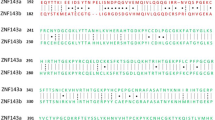Abstract
THE ZFY gene in the sex-determining region of the human Y chromosome encodes a protein with 13 zinc fingers, and may determine whether an embryo develops as a male or female1. ZFX, a related gene on the human X chromosome, may also function in sex determination; it encodes a protein with a very similar zinc-finger domain and escapes X inactivation1,2. ZFY and ZFX diverged from a common ancestral gene before the radiation of placental mammals, and retain a similar genomic organization2. Analysis of complementary DNAs from the mouse Y-chromosomal homologues of ZFY indicates that these genes encode probable transcription activators3,4. Here, we report that ZFX encodes a protein composed of a highly acidic amino-terminal domain, a basic putative nuclear-localization signal, and a carboxy-terminal zinc-finger domain. This combination of features, also found in the ZFY gene product, is typical of transcription activators. Alternative splicing generates ZFX transcripts encoding isoforms of 575 and 804 amino acids. These ZFX protein isoforms differ in the length of their acidic domains and may be functionally distinct.
Similar content being viewed by others
References
Page, D. C. et al. Cell 51, 1091–1104 (1987).
Schneider-Gädicke, A. et al. Cell 57, 1247–1258 (1989).
Mardon, G. & Page, D. C. Cell 56, 765–770 (1989).
Ashworth, A., Swift, S. & Affara, N. Nucleic Acids Res. 17, 2864 (1989).
Kozak, M. Cell 44, 283–292 (1986).
Ptashne, M. Nature 335, 683–689 (1988).
Mardon, G. et al. Molec. cell. Biol. (in the press).
Dang, C. V. & Lee, W. M. F. Molec. cell. Biol. 8, 4048–4054 (1988).
Dingwall, C. & Laskey, R. A. A. Rev. Cell Biol. 2, 367–390 (1986).
Miller, J., McLachlan, A. D. & Klug, A. EMBO J. 4, 1609–1614 (1985).
Brown, R. S., Sander, C. & Argos, P. FEBS Lett. 186, 271–274 (1985).
Ma, J. & Ptashne, M. Cell 48, 847–853 (1987).
Hope, I. A. & Struhl, K. Cell 46, 885–894 (1986).
Hollenberg, S. M. & Evans, R. M. Cell 55, 899–906 (1988).
Godowski, P. J., Picard, D. & Yamamoto, K. R. Science 241, 812–816 (1988).
Schmid, C. W. & Jelinek, W. R. Science 216, 1065–1070 (1982).
Fitzgerald, M. & Shenk, T. Cell 24, 251–260 (1981).
Maizel, J. V. & Lenk, R. P. Proc. natn. Acad. Sci. U.S.A. 78, 7665–7669 (1981).
Author information
Authors and Affiliations
Rights and permissions
About this article
Cite this article
Schneider-Gädicke, A., Beer-Romero, P., Brown, L. et al. Putative transcription activator with alternative isoforms encoded by human ZFX gene. Nature 342, 708–711 (1989). https://doi.org/10.1038/342708a0
Received:
Accepted:
Issue Date:
DOI: https://doi.org/10.1038/342708a0
- Springer Nature Limited
This article is cited by
-
ZFX regulates glioma cell proliferation and survival in vitro and in vivo
Journal of Neuro-Oncology (2013)
-
Differential expression of ZFX gene in gastric cancer
Journal of Biosciences (2012)
-
The Zfx gene is expressed in human gliomas and is important in the proliferation and apoptosis of the human malignant glioma cell line U251
Journal of Experimental & Clinical Cancer Research (2011)
-
Cloning and mapping of bovine ZFX gene to the long arm of the X-chromosome (Xq34) and homologous mapping of ZFY gene to the distal region of the short arm of the bovine (Yp13), ovine (Yp12–p13), and caprine (Yp12–p13) Y Chromosome
Mammalian Genome (1998)
-
AZFY-like sequence in fish, with comments on the evolution of theZFY family of genes in vertebrates
Biochemical Genetics (1995)





